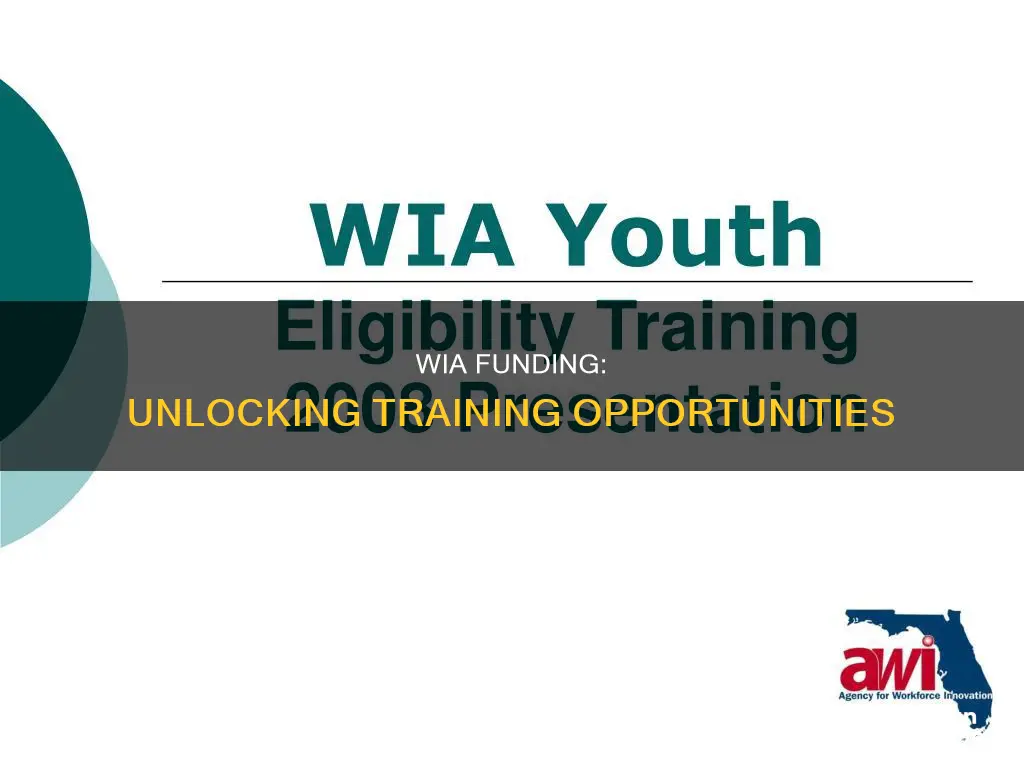
The Workforce Investment Act (WIA) was a United States federal law that was repealed and replaced by the 2014 Workforce Innovation and Opportunity Act. The WIA provided funding for job training and related services to unemployed and underemployed individuals. The WIA was focused on helping meet the needs of businesses and industries by providing training and education opportunities to individuals in the form of voucher-distributed Individual Training Accounts. The WIA was split into five titles that outline how the WIA accomplishes its goal of creating a system that provides a means to increase employment, retention, and earnings of individuals. The WIA funded three programs: Adult, Displaced Worker, and Youth. These programs were delivered through several thousand one-stop career centres located across the country.
| Characteristics | Values |
|---|---|
| Year of enactment | 1998 |
| Replaced | Job Training Partnership Act and certain other Federal and job training laws |
| Purpose | To increase employment, retention, and earnings of participants, and increase occupational skill attainment by participants, and, as a result, improve the quality of the workforce, reduce welfare dependency, and enhance the productivity and competitiveness of the Nation |
| Training programs | Adult, Displaced Worker, Youth, Job Corps, Native American Program, Migrant and Seasonal Farmworker Program, Veterans’ Workforce Investment Program, Responsible Reintegration for Young Offenders, Prisoner Reentry Program, Community-Based Job Training Grants, YouthBuild |
| Training services | Occupational skills training, on-the-job training, customised training, skill upgrading and retraining |
| Training funding | $5.31 billion in FY2009 |
| Training activities | Provided through a system of One-Stop Career Centers |
What You'll Learn

Training and education for adults and dislocated workers
The Workforce Investment Act (WIA) was a federal law passed in 1998 to provide workforce investment activities through statewide and local workforce investment systems. The WIA was designed to increase employment, retention, and earnings of participants, and to improve their occupational skill attainment. The WIA was repealed and replaced by the 2014 Workforce Innovation and Opportunity Act.
The WIA provided job training and related services to unemployed and underemployed individuals. It authorized several job training programs, including state formula grants for Adult, Youth, and Dislocated Worker Employment and Training Activities. These programs were administered by the Department of Labor (DOL), primarily through DOL's Employment and Training Administration (ETA).
The Adult and Dislocated Worker Program, under Title I of the WIA, was designed to provide quality employment and training services to assist eligible individuals in finding and qualifying for meaningful employment, and to help employers find skilled workers. To be eligible for this program, individuals had to be 18 years of age or older, or dislocated workers.
The WIA programs were provided through a system of One-Stop Career Centers, where individuals could access job training and referrals in their local area. The Act required the use of certain standards for success and provided for a one-stop delivery system.
The WIA also set up systems to help adults reach certain literacy levels to be successful in the workforce. Adult education was provided to help adults reach a minimum of an 8th-grade reading level before entering the workforce.
The WIA authorized grants and contracts to provide and conduct training, projects, and services. These included academic training for individuals providing rehabilitation services to individuals with disabilities, and training to maintain and upgrade basic skills for people providing service delivery and rehabilitation technology services.
The WIA also provided funding for community colleges and private training companies, which offered training and education services to individuals. However, the WIA has faced criticism for being overly bureaucratic and having insufficient funding to meet the demand for its services.
Cash Investments: Safe Haven or Missed Opportunities?
You may want to see also

Job Corps
The program helps eligible youth complete their high school education, trains them for meaningful careers, and assists them in obtaining employment. Since 1964, Job Corps has trained and educated over two million individuals.
- Advanced Manufacturing
- Automotive and Machine Repair
- Finance and Business
- Information Technology
- Renewable Resources and Energy
Students can earn a high school diploma or its equivalent, and college credits. Job Corps also offers tuition-free housing, meals, basic healthcare, a living allowance, and career transition assistance.
The program has faced criticism and scrutiny over the years, with reports of safety incidents, drug use, and questions about the effectiveness of its training. Despite this, it has survived with bipartisan Congressional support and continues to be a resource for young people seeking career development opportunities.
Dave Ramsey's Investment Advice: Right or Wrong?
You may want to see also

Native American Program
The Native American Program is a national "set-aside" program under Section 166 of the Workforce Investment Act (WIA) and its replacement, the Workforce Innovation and Opportunity Act (WIOA). The program is designed to provide employment and training services to unemployed, underemployed, and low-income Native Americans, Alaska Natives, and Native Hawaiians.
The program is administered by the Division of Indian and Native American Programs (DINAP) within the U.S. Department of Labor's Employment and Training Administration. DINAP shares a vision with WIOA Section 166 grantees to provide quality employment and training services to tribes, tribal organizations, Alaska Native entities, Indian-controlled organizations, and Native Hawaiian organizations.
The Native American Program supports employment and training activities to develop academic, occupational, and literacy skills, making individuals more competitive in the workforce and promoting economic and social development. The program is administered in a way that meets regulatory requirements and respects the traditional cultural values and beliefs of the communities it serves.
Under the program, grants and contracts are authorized to provide academic training and rehabilitation services to individuals with disabilities, as well as to conduct special projects and demonstrations that expand rehabilitation services. Vocational rehabilitation services are also provided to individuals with disabilities who are migrant or seasonal farmworkers. Additionally, grants are used to initiate recreational programs for individuals with disabilities to aid them in employment, mobility, socialization, independence, and community integration.
The program also authorizes training and information provision to individuals with disabilities and their representatives, helping them gain access to rehabilitation systems and statewide workforce investment systems, and become active decision-makers in the rehabilitation process.
The Native American Employment and Training Council, authorized by Section 166(i)(4) of the WIOA, provides advice to the Secretary of Labor regarding the provision of employment and training services to Native Americans through federal workforce development programs.
Invest or Repay: The Car Conundrum
You may want to see also

Migrant and Seasonal Farmworker Program
The Migrant and Seasonal Farmworker Program (MSFW) is a nationally directed program created by Congress to address the chronic seasonal unemployment and underemployment experienced by migrant and seasonal farmworkers. The program provides funding to help farmworkers and their families achieve economic self-sufficiency by offering supportive services while they work in agriculture or by helping them acquire new skills for better-paying jobs.
The National Farmworker Jobs Program (NFJP) is overseen by the Employment and Training Administration (ETA) and provides funding for community-based organizations and public agencies to provide career services, training services, youth services, related assistance services, and housing assistance to eligible migrant and seasonal farmworkers and their dependents. The ETA awards NFJP grants every four years through a Funding Opportunity Announcement.
The NFJP aims to help farmworkers and their dependents acquire the necessary skills to stabilize or advance in their agricultural jobs or obtain employment in new industries or occupations. It also assists these individuals in securing safe and sanitary permanent and temporary housing.
The Migrant and Seasonal Agricultural Worker Protection Act (MSPA) establishes employment standards related to wages, housing, transportation, disclosures, and record-keeping. The MSPA also requires farm labor contractors to register with the U.S. Department of Labor. The Act includes requirements such as agricultural employers disclosing terms of employment at the time of recruitment and complying with those terms, and providers of housing for farmworkers meeting local and federal housing standards.
The Farm Labor Stabilization and Protection Pilot Grant Program is a new initiative by the USDA to address labor shortages in agriculture, reduce irregular migration, and improve labor protections for farmworkers. The program aims to improve the resiliency of the food and agricultural supply chain by expanding the potential pool of workers, including through the H-2A visa program, and enhancing working conditions for both U.S. and H-2A workers.
Local Superfund Sites: Worthy Investment Opportunities
You may want to see also

Veterans' Workforce Investment Program
The Veterans Workforce Investment Program (VWIP) is a US federal grant program that provides funding for training and employment services for veterans. The program is authorized under the Workforce Investment Act of 1998 and is administered by the US Department of Labor's Veterans' Employment and Training Service (VETS). The VWIP aims to assist recently separated veterans, including those returning from tours of duty in Iraq and Afghanistan, in transitioning back into the civilian workforce. The program offers a range of services, including training, employment, support services, credentialing, and networking information.
The VWIP provides grants to state and local workforce investment boards, local public agencies, and nonprofit organizations, including faith-based and community organizations. These organizations are familiar with the local areas and populations they serve and have demonstrated their ability to administer effective programs. The grants are awarded on a competitive basis, with a focus on addressing universal, local, and regional issues that may impact veterans' re-entry into the workforce.
The VWIP places an emphasis on training veterans for "green jobs," including fields such as energy efficiency, renewable energy, modern electric-power development, and clean vehicles. Through the program, veterans receive skills assessments, individual job counseling, labor market information, classroom or on-the-job training, skills upgrading and retraining, and placement assistance. The VWIP also encourages direct services to veterans and outreach activities that result in job and training opportunities.
The VWIP is designed to be flexible, addressing a range of challenges faced by veterans re-entering the workforce. It aims to improve the quality of the workforce, reduce welfare dependency, and enhance the nation's productivity and competitiveness. The program is open to "recently separated" veterans who have left the service within the last 48 months and offers a pathway to gain the skills and credentials needed for successful reintegration into civilian careers.
Tomorrow's Investments: Where to Look
You may want to see also
Frequently asked questions
The Workforce Investment Act (WIA) was a federal law enacted in 1998 to provide workforce investment activities that increase employment, retention, and earnings of participants. It was repealed and replaced by the 2014 Workforce Innovation and Opportunity Act.
The WIA provides job training and related services to unemployed and underemployed individuals. It also provides employment and training services to eligible individuals to help them find and qualify for meaningful employment.
The WIA pays for occupational skills training, on-the-job training, customised training, and skill upgrading and retraining. It also covers the cost of supportive services such as transportation and child care.
The WIA helps employers find the skilled workers they need to compete and succeed in business.







